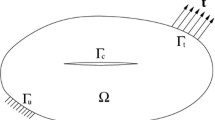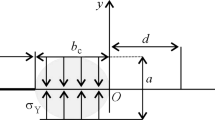Abstract
Recently, Khodabakhshi et al. (Meccanica 51(12):3129–3147, 2016. https://doi.org/10.1007/s11012-016-0560-6) presented a new method (by the name GraFEA) capable of studying fracture based on edge breakage within a classical FEA scheme which combines the best features of FEA and bond-breakage methods in a single framework. In this study, an attempt is made to investigate the mesh dependency of GraFEA by a set of numerical examples, and it is shown that using a local fracture criterion for edge failure will yield mesh-dependent results, as is already well known. A physically motivated nonlocal fracture criterion is implemented along with the edge breakage model, and its efficacy in eliminating the mesh sensitivity is investigated. The nonlocal criterion introduces a length scale into the problem. It is shown that by increasing the magnitude of the length scale parameter from zero, the damage pattern moves from localized fracture to diffuse damage pattern, yet with complete material separation (fracture) across a certain plane. It is shown by numerical results that, as expected, the introduction of the nonlocal fracture criterion eliminates the issue of mesh sensitivity, and thus predictions of the approximate crack paths and damage zone can be done within the classical FEA framework without the need for special formulations.



















Similar content being viewed by others
Notes
Linear triangular elements result in constant strains; therefore, the construction of the stiffness matrix does not require any numerical integration.
The question of whether or not the results are mesh dependent is influenced by what we choose to measure. Following the standard practice in considering mesh dependency of fracture mechanics problems, we mainly check whether the global response is similar. The second thing we check is whether crack paths and damage zones are qualitatively similar. Here, it should be noted that from an experimental point of view even two nominally identical specimens do not show identical crack paths. However, broad features of the fracture zones do show similarities.
The mesh generator used in this study is distmesh which gives approximately equilateral triangular elements. The average side length, \(a_{\text {avg}}\), is calculated over the elements which are located about the central horizontal line (refined area).
References
Khodabakhshi, P., Reddy, J.N., Srinivasa, A.: GraFEA: a graph-based finite element approach for the study of damage and fracture in brittle materials. Meccanica 51(12), 3129–3147 (2016). https://doi.org/10.1007/s11012-016-0560-6
Xu, X.P., Needleman, A.: Numerical simulations of fast crack growth in brittle solids. J. Mech. Phys. Solids 42(9), 1397–1434 (1994)
Camacho, G.T., Ortiz, M.: Computational modelling of impact damage in brittle materials. Int. J. Solids Struct. 33(20–22), 2899–2938 (1996)
Rabczuk, T., Belytschko, T.: Cracking particles: a simplified meshfree method for arbitrary evolving cracks. Int. J. Numer. Methods Eng. 61(13), 2316–2343 (2004)
Belytschko, T., Black, T.: Elastic crack growth in finite elements with minimal remeshing. Int. J. Numer. Methods Eng. 45(5), 601–620 (1999). https://doi.org/10.1002/(SICI)1097-0207(19990620)45:5<601::AID-NME598>3.0.CO;2-S
Moës, N., Dolbow, J., Belytschko, T.: A finite element method for crack growth without remeshing. Int. J. Numer. Methods Eng. 46(1), 131–150 (1999). https://doi.org/10.1002/(SICI)1097-0207(19990910)46:1<131::AID-NME726>3.0.CO;2-J
Moës, N., Belytschko, T.: Extended finite element method for cohesive crack growth. Eng. Fract. Mech. 69(7), 813–833 (2002). https://doi.org/10.1016/S0013-7944(01)00128-X
Pijaudier-Cabot, G., Bažant, Z.P.: Nonlocal damage theory. J. Eng. Mech. 113(10), 1512–1533 (1987)
Bažant, Z.P., Pijaudier-Cabot, G.: Nonlocal continuum damage, localization instability and convergence. J. Appl. Mech. 55(2), 287–293 (1988)
Jirsek, M., Zimmermann, T.: Rotating crack model with transition to scalar damage. J. Eng. Mech. 124(3), 277–284 (1998). https://doi.org/10.1061/(ASCE)0733-9399(1998)124:3(277)
Bažant, Z.P.: Instability, ductility and size effect in strain-softening concrete. J. Eng. Mech. Div. ASCE 102, 331–344 (1975)
Bažant, Z.P., Cedolin, L.: Finite element modeling of crack band propagation. J. Struct. Eng. 109(1), 69–92 (1983)
Bažant, Z.P., Oh, B.H.: Crack band theory for fracture of concrete. Matér. Constr. 16(3), 155–177 (1983). https://doi.org/10.1007/BF02486267
Bažant, Z.P., Jirásek, M.: Nonlocal integral formulations of plasticity and damage: survey of progress. J. Eng. Mech. 128(11), 1119–1149 (2002)
Needleman, A.: Material rate dependence and mesh sensitivity in localization problems. Comput. Methods Appl. Mech. Eng. 67(1), 69–85 (1988). https://doi.org/10.1016/0045-7825(88)90069-2
Triantafyllidis, N., Aifantis, E.C.: A gradient approach to localization of deformation. I. Hyperelastic materials. J. Elast. 16(3), 225–237 (1986). https://doi.org/10.1007/BF00040814
Lasry, D., Belytschko, T.: Localization limiters in transient problems. Int. J. Solids Struct. 24(6), 581–597 (1988). https://doi.org/10.1016/0020-7683(88)90059-5
Peerlings, R.H.J., Geers, M.G.D., De Borst, R., Brekelmans, W.A.M.: A critical comparison of nonlocal and gradient-enhanced softening continua. Int. J. Solids Struct. 38(44), 7723–7746 (2001)
Peerlings, R., De Borst, R., Brekelmans, W., Geers, M.: Localisation issues in local and nonlocal continuum approaches to fracture. Eur. J. Mech. A Solids 21(2), 175–189 (2002)
Bažant, Z.P., Belytschko, T.B., Ta-Peng, C.: Continuum theory for strain-softening. J. Eng. Mech. 110(12), 1666–1692 (1984). https://doi.org/10.1061/(ASCE)0733-9399(1984)110:12(1666)
Belytschko, T., Bažant, Z.P., Yul-Woong, H., Ta-Peng, C.: Strain-softening materials and finite-element solutions. Comput. Struct. 23(2), 163–180 (1986). https://doi.org/10.1016/0045-7949(86)90210-5
Jirásek, M.: Nonlocal models for damage and fracture: comparison of approaches. Int. J. Solids Struct. 35(31–32), 4133–4145 (1998)
Challamel, N., Wang, C.M.: The small length scale effect for a non-local cantilever beam: a paradox solved. Nanotechnology 19(34), 345703 (2008)
Challamel, N.: Variational formulation of gradient or/and nonlocal higher-order shear elasticity beams. Compos. Struct. 105(Supplement C), 351–368 (2013). https://doi.org/10.1016/j.compstruct.2013.05.026
Srinivasa, A.R., Reddy, J.N.: An overview of theories of continuum mechanics with nonlocal elastic response and a general framework for conservative and dissipative systems. Appl. Mech. Rev. 69(3), 030802 (18) (2017). https://doi.org/10.1115/1.4036723
Needleman, A.: Some issues in cohesive surface modeling. In: Procedia IUTAM, Mechanics for the World: Proceedings of the 23rd International Congress of Theoretical and Applied Mechanics, ICTAM2012, vol. 10, pp. 221–246 (2014). https://doi.org/10.1016/j.piutam.2014.01.020
de Borst, R., Remmers, J.J.C., Needleman, A.: Mesh-independent discrete numerical representations of cohesive-zone models. Eng. Fract. Mech. 73(2), 160–177 (2006)
Song, J.-H., Wang, H., Belytschko, T.: A comparative study on finite element methods for dynamic fracture. Comput. Mech. 42(2), 239–250 (2008)
Silling, S.A.: Reformulation of elasticity theory for discontinuities and long-range forces. J. Mech. Phys. Solids 48(1), 175–209 (2000). https://doi.org/10.1016/S0022-5096(99)00029-0
Silling, S.A., Epton, M., Weckner, O., Xu, J., Askari, E.: Peridynamic states and constitutive modeling. J. Elast. 88(2), 151–184 (2007). https://doi.org/10.1007/s10659-007-9125-1
Seleson, P.D.: Peridynamic multi scale models for the mechanics of materials: constitutive relations, upscaling from atomistic systems, and interface problems. Ph.D. thesis, Florida State University (2010)
Henke, S.F., Shanbhag, S.: Mesh sensitivity in peridynamic simulations. Comput. Phys. Commun. 185(1), 181–193 (2014). https://doi.org/10.1016/j.cpc.2013.09.010
Seleson, P., Parks, M.: On the role of the influence function in the peridynamic theory. Int. J. Multiscale Comput. Eng. 9(6), 689–706 (2011)
Bobaru, F., Zhang, G.: Why do cracks branch? A peridynamic investigation of dynamic brittle fracture. Int. J. Fract. 196(1), 59–98 (2015). https://doi.org/10.1007/s10704-015-0056-8
Dipasquale, D., Sarego, G., Zaccariotto, M., Galvanetto, U.: Dependence of crack paths on the orientation of regular 2d peridynamic grids. Eng. Fract. Mech. 160, 248–263 (2016). https://doi.org/10.1016/j.engfracmech.2016.03.022
Ghajari, M., Iannucci, L., Curtis, P.: A peridynamic material model for the analysis of dynamic crack propagation in orthotropic media. Comput. Methods Appl. Mech. Eng. 276, 431–452 (2014). https://doi.org/10.1016/j.cma.2014.04.002
Hu, W., Ha, Y.D., Bobaru, F.: Peridynamic model for dynamic fracture in unidirectional fiber-reinforced composites. Comput. Methods Appl. Mech. Eng. 217–220, 247–261 (2012). https://doi.org/10.1016/j.cma.2012.01.016
Seleson, P., Du, Q., Parks, M.L.: On the consistency between nearest-neighbor peridynamic discretizations and discretized classical elasticity models. Comput. Methods Appl. Mech. Eng. 311, 698–722 (2016). https://doi.org/10.1016/j.cma.2016.07.039
Reddy, J.N., Srinivasa, A.R.: On the force-displacement characteristics of finite elements for elasticity and related problems. Finite Elem. Anal. Des. 104, 35–40 (2015)
Reddy, J.N.: An Introduction to the Finite Element Method. McGraw Hill, New York (2006)
Ritchie, R.O., Knott, J.F., Rice, J.R.: On the relationship between critical tensile stress and fracture toughness in mild steel. J. Mech. Phys. Solids 21(6), 395–410 (1973)
Lin, T., Evans, A.G., Ritchie, R.O.: A statistical model of brittle fracture by transgranular cleavage. J. Mech. Phys. Solids 34(5), 477–497 (1986)
Mao, Y., Talamini, B., Anand, L.: Rupture of polymers by chain scission. Extreme Mech. Lett. 13, 17–24 (2017). https://doi.org/10.1016/j.eml.2017.01.003
Pang, S.-D., Bažant, Z.P., Le, J.-L.: Statistics of strength of ceramics: finite weakest-link model and necessity of zero threshold. Int. J. Fract. 154(1), 131–145 (2008). https://doi.org/10.1007/s10704-009-9317-8
De Borst, R., Sluys, L.J., Muhlhaus, H.-B., Pamin, J.: Fundamental issues in finite element analyses of localization of deformation. Eng. Comput. 10(2), 99–121 (1993)
Acknowledgements
The first two authors gratefully acknowledge the support of the present research by the Oscar S. Wyatt Endowed Chair.
Author information
Authors and Affiliations
Corresponding author
Additional information
Publisher's Note
Springer Nature remains neutral with regard to jurisdictional claims in published maps and institutional affiliations.
Appendix: Convergence study of nonlocal to local fracture criterion
Appendix: Convergence study of nonlocal to local fracture criterion
In this Appendix, numerical results are provided to prove the convergence of the results from a nonlocal fracture criterion to those of a local fracture criterion with decreasing values of the length scale parameter (\(\ell _\mathrm{c} \rightarrow 0\)). The problem of Sect. 5.1 is reconsidered here with different values for the length scale parameter (\(\ell _\mathrm{c}/r\) starting from 0 and increasing in increments of 1% from 0 to 10%, and increasing in increments of 2% from 10 to 20%). The value of \(\ell _\mathrm{c}=0\%\) corresponds to the local fracture criterion, and \(\ell _\mathrm{c}>0\%\) corresponds to a nonlocal fracture criterion. Figure 18 depicts the damage zone for varying values of the length scale parameter, and one can notice that as \(\ell _\mathrm{c}\) decreases the crack path for the nonlocal fracture criterion approaches that of the local fracture criterion.
Figure 19 demonstrates the force–displacement relationship diagram for different values of \(\ell _\mathrm{c}\) for the problem of the study. Once again the convergence from a nonlocal to a local fracture criterion with decreasing values of the length scale parameter is obvious.
Rights and permissions
About this article
Cite this article
Khodabakhshi, P., Reddy, J.N. & Srinivasa, A. A nonlocal fracture criterion and its effect on the mesh dependency of GraFEA. Acta Mech 230, 3593–3612 (2019). https://doi.org/10.1007/s00707-019-02479-8
Received:
Revised:
Published:
Issue Date:
DOI: https://doi.org/10.1007/s00707-019-02479-8




